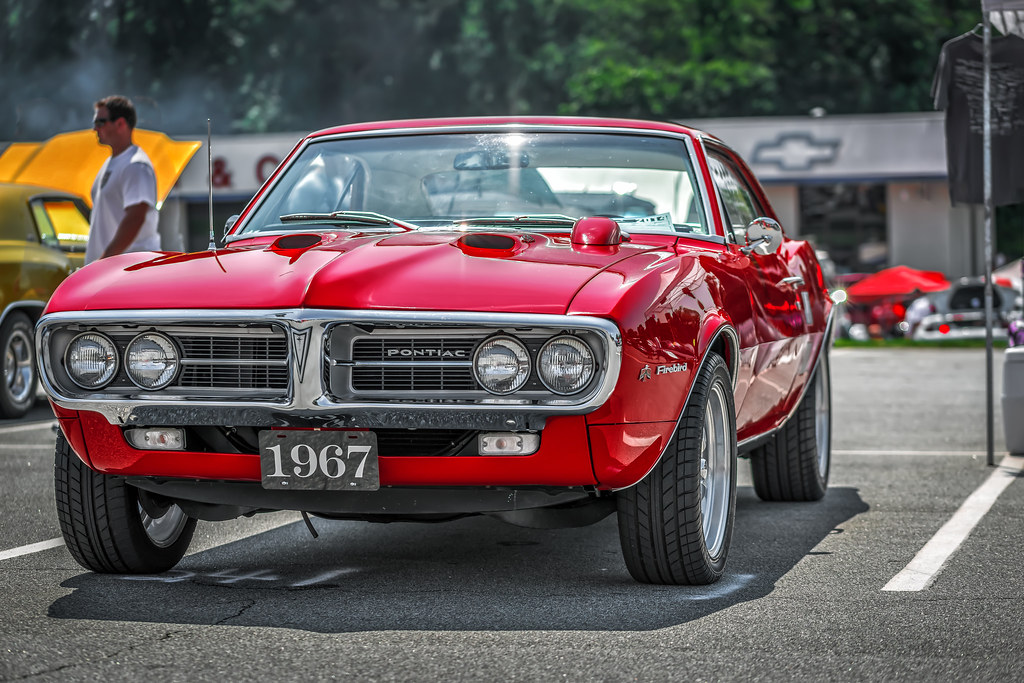
Vintage cars are far more than mere machines; they are rolling pieces of history, embodying the peak of automotive innovation and craftsmanship from their respective eras. For dedicated collectors and passionate enthusiasts alike, these classic automobiles represent the zenith of design, engineering, and performance, standing as timeless testaments to human ingenuity and a relentless pursuit of perfection. Their enduring allure lies not just in their aesthetic beauty or raw power, but in the stories they tell—tales of engineering breakthroughs, fierce competition, and profound cultural impact.
Over the decades, a select few vintage cars have transcended their original purpose, transforming into highly prized assets now worth millions, and in some extraordinary cases, even hundreds of millions. These vehicles don’t just offer sheer driving pleasure; they encapsulate moments in time, showcasing design philosophies that were decades ahead of their contemporaries and track records that etched their names into the annals of motorsport legend. The classic car market has experienced an unprecedented surge, turning desirable automobiles into investments rivaling fine art and real estate, largely driven by a generation now with the means to acquire their childhood dreams.
From the hallowed grounds of Formula 1 to the opulent boulevards of pre-war Europe, the cars we’re about to explore have achieved mythical status. They are the automotive masterpieces that have redefined what’s possible, not just in terms of speed and luxury, but in their sheer ability to command awe and astronomical prices. Join us on an exhilarating journey as we delve into seven of these one-of-a-kind classic cars, each a jewel in the crown of automotive history, whose values have not just appreciated but have truly skyrocketed.
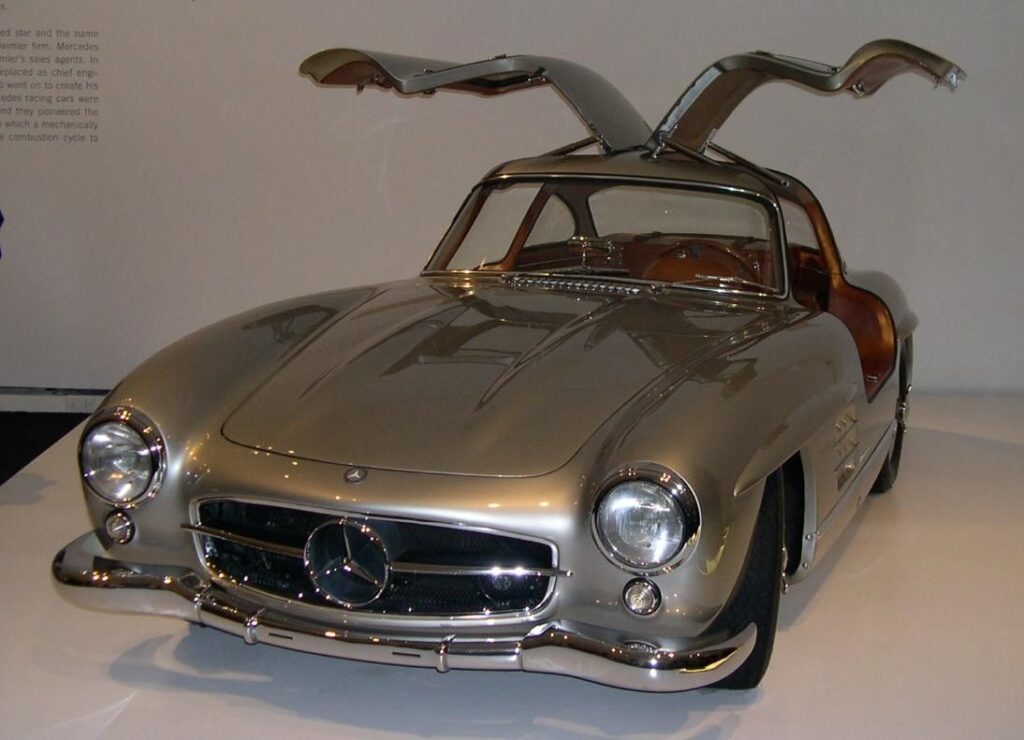
1. **1955 Mercedes-Benz 300 SLR Uhlenhaut Coupe: The Holy Grail of Automotive Engineering**If ever there was a car that represented the absolute pinnacle of sleek German engineering from the 1950s, it is undoubtedly the 1955 Mercedes-Benz 300 SLR Uhlenhaut Coupe. This magnificent machine holds the undisputed record as the most expensive car ever sold, fetching an astonishing sum of over $142 million at a private sale. Its value isn’t just a testament to its beauty, but to its unparalleled rarity and the sheer brilliance of its design.
Named after its chief engineer, Rudolf Uhlenhaut, who famously used one as his personal company car, these vehicles were road-legal versions of the dominant W196R Formula 1 car. Only two of these coupes were ever built, making them rarer than the most precious gems imaginable. This extreme scarcity, combined with a direct lineage to Mercedes-Benz’s Formula 1 racing success, crafts a narrative of exclusivity that few other cars can rival.
What set the Uhlenhaut Coupe apart was its exceptional performance, a characteristic that was truly decades ahead of its time. It boasted a formidable 3.0-liter straight-eight engine, adapted from the Grand Prix car, capable of achieving incredible speeds. The combination of its Formula 1 pedigree, the ultimate rarity of only two examples, and its profound historical significance creates a value that stretches beyond any conventional imagination, shattering all previous automotive records.
Car Model Information: 2020 Audi Q5 45 Premium
Caption: Mercedes-Benz Museum
CarName: Mercedes-Benz 300 SLR
Category: World Sportscar Championship
Constructor: Mercedes-Benz in Formula One
Team: Mercedes-Benz in Formula One
Drivers: flagicon,Stirling Moss,flagicon,Pierre Levegh
EngineName: Mercedes-Benz M196 engine
Configuration: straight-8
Capacity: 2982 cc
Abbr: on
EnginePosition: front-mid
GearboxName: Daimler-Benz
Type: 5-speed transaxle gearbox
FrontSuspension: Double wishbone, torsion bar springs, telescopic shock absorbers
RearSuspension: Single-joint swing axle, longitudinal torsion-bar springs, telescopic shock absorbers
Fuel: Super petrol (98 RON)
Tyres: Continental AG
Debut: 1955 Mille Miglia
Designer: Rudolf Uhlenhaut
Categories: 24 Hours of Le Mans race cars, All articles with unsourced statements, Articles with short description, Articles with unsourced statements from May 2023, Automobiles with gull-wing doors
Summary: The Mercedes-Benz 300 SLR (W 196 S) is a two-seat sports racing car that took part in the 1955 World Sportscar Championship before a catastrophic crash and fire at Le Mans later that year ended its domination prematurely. The car was designated “SL-R” (for Sport, Leicht, Rennen, eng: sport, light, racing), which was later condensed to “SLR”. Technically, the W 196 S is based on the W 196 R, but has a slightly different engine, displacing 3 litres.
Just as the W 196 R Formula One racer’s M 196 R engine, the 300 SLR’s M 196 S engine is a direct-injected 3-litre straight-eight engine (but with a 78 mm bore and stroke); its rated power is 302 PS (222 kW).
The W 196 S’s monoposto driving position was modified to standard two-abreast seating, headlights were added, and a few other changes made to adapt a strictly track competitor to a 24-hour road/track sports racer.
Hall of Fame Formula One driver and former Mercedes-Benz team 300 SLR race driver Stirling Moss described the 300 SLR as “The greatest sports racing car ever built – really an unbelievable machine.”
Two of the nine 300 SLR rolling chassis produced (nicknamed the “Uhlenhaut Coupé”) were built as closed coupés. Effectively road legal racers, they had coupé styling and gull-wing doors, superficially resembling the 300 SL production car.
When Mercedes-Benz cancelled its racing programme after the Le Mans disaster, the hybrid project was shelved. Company design chief Rudolf Uhlenhaut, architect of both the 300 SLR racer and the hybrids, appropriated one of the leftover mules as his personal car. Capable of approaching 290 km/h (180 mph), the Uhlenhaut Coupé was by far the fastest road car in the world in its day.
A 1955 Mercedes-Benz 300 SLR Uhlenhaut Coupé has become the most expensive car to ever be sold after being auctioned off for €135 million. The car, previously owned by Mercedes-Benz, was sold by RM Sotheby’s to an unknown collector at the Mercedes-Benz Museum on 5 May 2022.
Get more information about: Mercedes-Benz 300 SLR
Buying a high-performing used car >>>
Brand: Mercedes-Benz Model: 300 SLR Uhlenhaut Coupe
Price: $20,955 Mileage: 51,510 mi.

2. **1962 Ferrari 250 GTO: The Quintessential Collector’s Dream**For any car enthusiast who came of age in the 1960s and 70s, the legendary Ferrari 250 GTO was not just a car; it was a poster on their bedroom wall, a symbol of ultimate aspiration. Today, it remains the quintessential collector car, consistently commanding between $50 million and $70 million at auction, solidifying its status as the “Holy Grail” for automotive connoisseurs.
Only 36 examples of the 250 GTO were ever built, each carrying a unique and storied racing history. These cars weren’t merely beautiful; they were built to win, and win they did, securing three consecutive FIA World GT Championships. The stunning design, penned by Sergio Scaglietti, perfectly blended aerodynamic efficiency with undeniable Italian artistry, creating a shape that remains iconic and breathtaking.
The heart of the 250 GTO was a potent 3.0-liter V12 engine, meticulously tuned for competition, that delivered both exhilarating performance and a captivating soundtrack. Its rarity, coupled with an illustrious racing pedigree that included victories in prestigious races like Le Mans and the Tour de France, makes it one of the most coveted and expensive cars in history. According to auction records, owning a 250 GTO means possessing a perfect storm of Italian craftsmanship, racing success, and exclusivity, an investment in both history and unparalleled beauty.
Car Model Information: 2020 Audi Q5 45 Premium
Name: Ferrari 250 GTO
Caption: 1963 Ferrari 250 GTO (chassis 4153GT)
Manufacturer: Ferrari
Production: 1962–1964,(36 produced)
Designer: Giotto Bizzarrini,Scaglietti
Class: Sports car
BodyStyle: berlinetta
Related: Ferrari 330#330 LMB,Ferrari P#250 LM
Layout: FR layout
Engine: 2,953 cc,Ferrari Colombo engine#250,Overhead camshaft#Single Overhead camshatf,Weber carburetor,Compression ratio
Powerout: 300 PS
Abbr: on
Order: flip @ 5500 rpm
Transmission: Manual transmission
Wheelbase: 2400 mm
Length: 4325 mm
Width: 1600 mm
Height: 1210 mm
Weight: convert
Predecessor: Ferrari 250 GT SWB
Successor: Ferrari 250 LM,Ferrari 288 GTO
Categories: All articles lacking reliable references, All articles needing additional references, All articles with bare URLs for citations, All articles with unsourced statements, Articles lacking reliable references from March 2022
Summary: The Ferrari 250 GTO is a grand tourer produced by Ferrari from 1962 to 1964 for homologation into the FIA’s Group 3 Grand Touring Car category. It was powered by Ferrari’s Tipo 168/62 Colombo V12 engine. The “250” in its name denotes the displacement in cubic centimeters of each of its cylinders; “GTO” stands for Gran Turismo Omologato, Italian for “Grand Touring Homologated”.
Just 36 of the 250 GTOs were manufactured between 1962 and 1964. This includes 33 cars with 1962–63 bodywork (Series I) and three with 1964 (Series II) bodywork similar to the Ferrari 250 LM. Four of the older 1962–1963 (Series I) cars were updated in 1964 with Series II bodies.
When new, the 250 GTO cost $18,000 in the United States, with buyers personally approved by Enzo Ferrari and his dealer for North America, Luigi Chinetti. This model has since become highly desired by automobile collectors and sales have repeatedly set price records. The current record for world’s most expensive Ferrari was set in June 2018 when a 1963 250 GTO (chassis 4153GT) was sold in a private sale for $70 million.
In 2004, Sports Car International placed the 250 GTO eighth on their list of Top Sports Cars of the 1960s, and nominated it the top sports car of all time. Similarly, Motor Trend Classic placed the 250 GTO first on a list of the “Greatest Ferraris of All Time”. Popular Mechanics named it the “Hottest Car of All Time”.
Get more information about: Ferrari 250 GTO
Buying a high-performing used car >>>
Brand: Ferrari Model: 250 GTO
Price: $20,955 Mileage: 51,510 mi.

3. **1936 Bugatti Type 57SC Atlantic: An Art Deco Masterpiece of Pre-War Elegance**Before the world plunged into the turmoil of World War II, there was a golden era when automotive design reached artistic heights that continue to captivate and take one’s breath away today. The 1936 Bugatti Type 57SC Atlantic stands as a towering testament to this period, representing the absolute pinnacle of pre-war automotive artistry and innovation.
Its most distinctive feature is the riveted “fin” running boldly down the center of its highly aerodynamic body, a design element that was both functional and aesthetically groundbreaking. Only four of these magnificent vehicles were ever built, making it one of the rarest and most visually striking cars ever conceived. Its design was so advanced for 1936 that it retains a futuristic quality even by modern standards, blending sculptural beauty with engineering audacity.
The Atlantic was powered by a supercharged 3.3-liter inline-eight engine, providing performance that was as impressive as its looks. Private sales tracked by leading valuation tools suggest values upwards of $30 million to $40 million, although finding one for sale is an almost impossible task due to its extreme rarity. This Bugatti is not just a car; it is a rolling sculpture, a masterpiece that forever changed perceptions of automotive art and continues to inspire designers worldwide.
Car Model Information: 2020 Audi Q5 45 Premium
Name: Bugatti Type 57
Caption: 1936 Bugatti Type 57 Atalante
Manufacturer: Bugatti
Assembly: Molsheim
Production: 1934–1940,710 produced
Designer: Jean Bugatti
Class: Grand tourer
Engine: DOHC,Straight-8
Predecessor: Bugatti Type 49
Successor: Bugatti Type 101
Categories: 24 Hours of Le Mans race cars, Articles with short description, Bugatti automobiles, CS1 Romanian-language sources (ro), Cars introduced in 1934
Summary: The Bugatti Type 57 and later variants (including the famous Atlantic and Atalante) was a grand tourer built from 1934 through 1940. It was an entirely new design created by Jean Bugatti, son of founder Ettore. A total of 710 Type 57s were produced.
Type 57s used a straight-8 twin-cam engine of 3.3 L (3257 cc/198 in³) displacement. Bore and stroke were 72 mm by 100 mm based on that of the Type 49 but heavily modified by Jean Bugatti, unlike the single cam engines of the Type 49 and earlier models. The engines of the Type 50, 51 used bevel gears at the front of the engine to transmit power from the crankshaft, whereas the Type 57 used a train of spur gears at the rear of the engine, with fiber gear wheels on the camshafts to achieve more silence in operation.
There were two basic variants of the Type 57 car:
The original Type 57
The lowered Type 57S/SC
The Type 57 chassis and engine was revived in 1951 as the Bugatti Type 101. A rediscovered Type 57 was sold for 3.4 million euros at auction on 7 February 2009 at a motor show in Paris.
Get more information about: Bugatti Type 57
Buying a high-performing used car >>>
Brand: Bugatti Model: Type 57SC Atlantic
Price: $20,955 Mileage: 51,510 mi.

4. **1957 Ferrari 335 S Scaglietti: Racing Royalty from the Golden Age of Motorsport**In the glorious and, at times, dangerous golden age of motorsport, when racing cars were celebrated as beautiful works of art, the 1957 Ferrari 335 S Scaglietti reigned among the elite. This powerful racing machine was engineered for victory, competing fiercely in legendary endurance events such as Le Mans and the grueling Mille Miglia—races that not only captured the world’s imagination but also defined automotive excellence.
With its successful racing history and incredibly limited production, it’s no surprise that these cars consistently command around $35 million at auction, and in some cases, even higher figures. The 335 S was a technological marvel of its time, powered by a potent 4.0-liter V12 engine producing an impressive 390 horsepower, capable of pushing the car to a top speed of 186 mph. This raw power, combined with its stunning Scaglietti bodywork, made it an intimidating presence on any track.
The car was piloted by a roster of legendary racers, including Stirling Moss, Wolfgang von Trips, and Maurice Trintignant, further cementing its place in motorsport history. The 335 S represents an era when Ferrari’s racing program was meticulously defining what it truly meant to be a sports car manufacturer, blending passion, engineering, and sheer speed. Owning one today is not just an investment; it is to possess a tangible piece of that glorious and defining chapter in racing history.
Car Model Information: 2020 Audi Q5 45 Premium
Name: Ferrari 335 S
Manufacturer: Ferrari
Aka: Ferrari 335 Sport
Production: 1957–1958,4 made (two converted from 315 S chassis)
Designer: Carrozzeria Scaglietti
Class: sports racing car
BodyStyle: Roadster (automobile)
Layout: Mid-engine design#FMR layout – Front Mid-engine / Rear-wheel drive
Engine: Ferrari Jano engine,V12 engine
Powerout: cvt
Transmission: Manual transmission
Wheelbase: 2350 mm
Abbr: on (dry)
Related: Ferrari 290 MM
Weight: 880 kg
Predecessor: Ferrari 315 S
Successor: Ferrari 250 TR
Categories: 24 Hours of Le Mans race cars, Articles with short description, Commons category link is on Wikidata, Ferrari vehicles, Mille Miglia
Summary: The Ferrari 335 S was a sports racing car produced by Italian automobile manufacturer Ferrari between 1957 and 1958. The car was a direct response to the Maserati 450S which with its 4.5-litre engine was threatening to overpower the 3.8-litre 315 S and 3.5-litre 290 MM. Four cars were produced in total.
Get more information about: Ferrari 335 S
Buying a high-performing used car >>>
Brand: Ferrari Model: 335 S Scaglietti
Price: $20,955 Mileage: 51,510 mi.
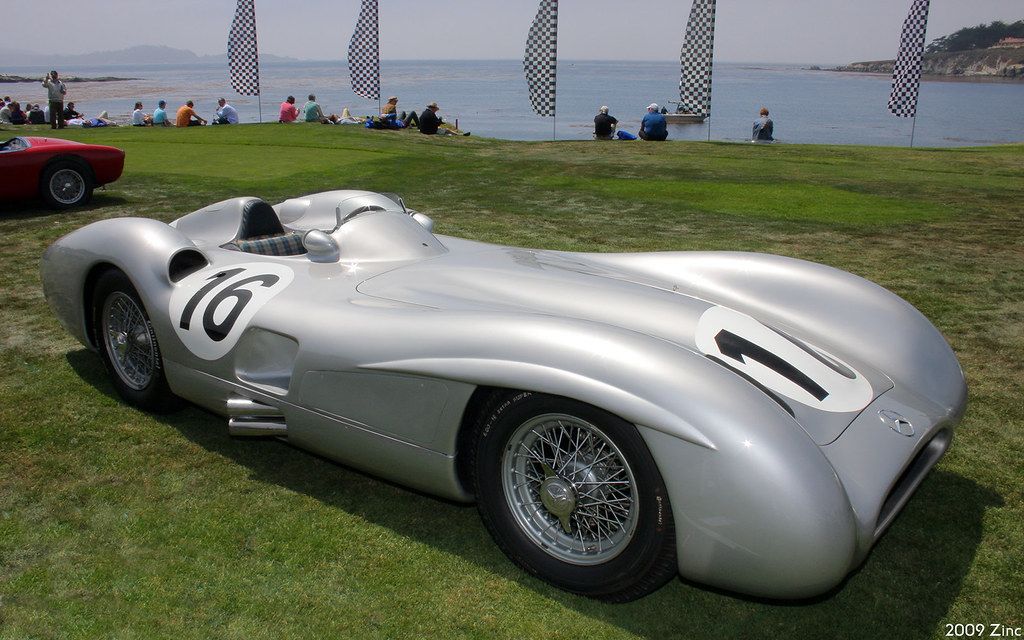
5. **1954 Mercedes-Benz W196R Formula 1 Silver Arrow: The Pinnacle of German Precision**For anyone who followed Formula 1 in the mid-1950s, the Mercedes-Benz W196R was an undeniable force, recognized as one of the most dominant racing machines ever conceived. Driven by legends such as Juan Manuel Fangio, this ‘Silver Arrow’ was a technological marvel that fundamentally redefined the boundaries of what was possible in motorsport, embodying German precision at its finest.
These sleek, aerodynamic F1 cars featured an advanced 2.5-liter straight-eight engine and cutting-edge engineering, giving them an unmatched advantage on the track. The W196R, with chassis 0006/54, notably won both the Swiss and German Grand Prix in 1954, under the masterful hand of Juan Manuel Fangio, significantly contributing to his extraordinary profile as a driver. Auction records show these historic F1 cars reaching between $29 million and $30 million, a figure that only hints at their true value.
The profound significance of the W196R lies not just in its monetary worth, but in its motorsport legacy. It was the car that dramatically reinstituted Mercedes-Benz into the Ferrari- and Maserati-dominated racing world, albeit for a brief, but brilliant, reign. Owning a car driven by Fangio during his championship seasons is akin to possessing a direct link to Formula 1 royalty, a testament to unparalleled engineering and racing prowess that echoed through history.
_(cropped).jpg/653px-Aston_Martin_DBS_-_Flickr_-_Alexandre_Pr%C3%A9vot_(11)_(cropped).jpg)
6. **1956 Aston Martin DBR1: The Embodiment of British Racing Glory**Long before the iconic association with James Bond propelled Aston Martin into a household name, the DBR1 was already making its indelible mark on automotive history on the world’s most prestigious racing circuits. Resplendent in its British Racing Green livery, this iconic machine achieved automotive immortality by clinching victory at the arduous 1959 24 Hours of Le Mans, a triumph that forever solidified Aston Martin’s formidable racing credentials.
The DBR1 was the brainchild of British entrepreneur and engineer David Brown, who dreamt of Le Mans victory. This particular car, although not the specific vehicle that won that storied race, was the first of only five DBR1s ever constructed and notably won the 1959 Nürburgring. Its elegant design, characterized by smooth lines and a purposeful stance, combined with a successful pedigree, has cemented its status as a collector’s ultimate dream.
Powered by a robust 2.9-liter straight-six engine, the DBR1 delivered formidable performance for its era. Bonhams auction records show these masterpieces exceeding $22 million, reflecting both their rarity and racing prestige. For enthusiasts who recall the era when British sports cars dominated international racing, the DBR1 represents the absolute pinnacle of that golden age, marrying sophisticated engineering with the kind of racing success that legends are born from.
Car Model Information: 2020 Audi Q5 45 Premium
CarName: Aston Martin DBR1
Caption: Aston Martin DBR1/5 at Silverstone Classic 2007
Category: 24 Hours of Le Mans#Cars,Sports car racing
Constructor: Aston Martin Lagonda Limited
Designer: Ted Cutting
Team: flagicon,Border Reivers (racing team)
Drivers: flagicon,Reg Parnell
Chassis: space frame
FrontSuspension: Torsion bar suspension
RearSuspension: De Dion tube
Length: 13 ft
Abbr: on
Width: 5 ft
Height: 3 ft
Wheelbase: 7 ft
Track: 4 ft
EngineName: Aston Martin
Power: Convert
Capacity: 2,493 cc / 2,992 cc,
Configuration: Straight six,
EnginePosition: Front-engine, rear-wheel drive layout
GearboxName: David Brown CG537
Gears: 5-speed
Type: Manual transmission
Weight: 1765 lb
Tyres: Avon Tyres#Avon Rubber plc
Debut: 1956 24 Hours of Le Mans
Races: 18,Inc 4 Le Mans
Wins: 9,Inc 1959 Le Mans
ConsChamp: 1 (1959)
Categories: 24 Hours of Le Mans race cars, Articles with hAudio microformats, Articles with short description, Aston Martin racing cars, Commons category link is on Wikidata
Summary: The Aston Martin DBR1 is a sports racing car built by Aston Martin starting in 1956, intended for the World Sportscar Championship as well as non-championship sportscar races at the time. It is most famous as the victor of the 1959 24 Hours of Le Mans, Aston Martin’s only outright victory at the endurance classic. It is one of only three cars in the 1950s to win both the World Sports Car Championship and Le Mans 24 Hours in the same year (the others being the Ferrari 375 Plus in 1954 and the Ferrari 250TR in 1958). In addition the six World Sports Car Championship victories was a record for any car in the 1950s and remained a record in the championship until surpassed by the Ferrari 250TR. The three consecutive triumphs in 1959 at the Nürburgring, Le Mans and the Tourist Trophy equalled the record set by the Ferrari 250TR with its three consecutive victories at the start of the 1958 season.
In August 2017, car DBR1/1 was sold for a world record price for a British-made car of US$22,555,000.
Get more information about: Aston Martin DBR1
Buying a high-performing used car >>>
Brand: Aston Martin Model: DBR1
Price: $20,955 Mileage: 51,510 mi.
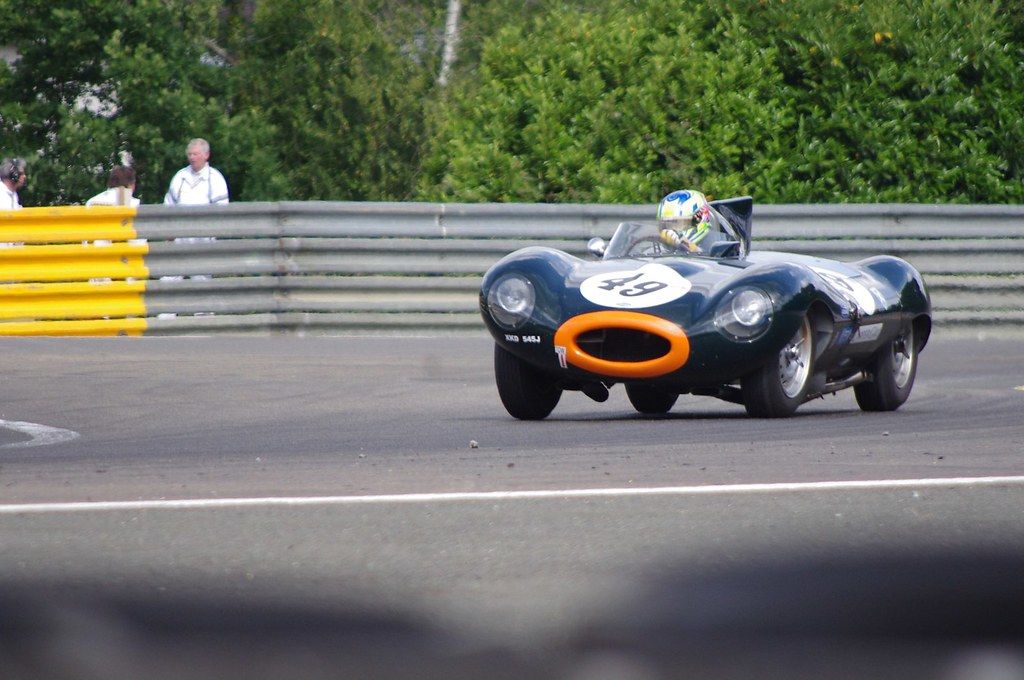
7. **1955 Jaguar D-Type: The Le Mans Conqueror with Revolutionary Design**In the mid-1950s, a singular car emerged to dominate the most grueling race in the world with an unparalleled blend of style, innovation, and unprecedented success. The 1955 Jaguar D-Type, instantly recognizable by its revolutionary aerodynamic design and distinctive stabilizing fin, achieved an extraordinary feat by winning Le Mans three consecutive times, forging a legacy that continues to resonate powerfully today.
This purebred racing machine was a marvel of British engineering excellence, combining a lightweight monocoque chassis with cutting-edge aerodynamics. Its 3.4-liter straight-six engine produced 250 horsepower, propelling the car to blistering speeds, including an average of 104.47 mph during the 1955 Le Mans and a staggering 156.868 mph on the Mulsanne Straight. The D-Type’s greatest hour came during the 1957 Le Mans, where it swept the field, securing first, second, third, fourth, and sixth positions.
Auction records from major houses consistently show D-Types reaching around $21 million, though their true value for enthusiasts who witnessed its Le Mans victories is immeasurable, representing pure racing nobility. As automotive experts often note, few cars can lay claim to such a perfect and compelling combination of inherent beauty, technological innovation, and an unparalleled record of racing success on the world stage.
Having explored some of the most iconic and astronomically valued automotive masterpieces that have already shattered records, our journey through the annals of motoring history is far from over. The world of classic cars is replete with other legends, each possessing a unique blend of engineering brilliance, artistic design, and a captivating backstory that continues to enchant collectors and enthusiasts around the globe. These vehicles are not merely old cars; they are tangible pieces of heritage, representing pivotal moments in automotive evolution and culture.
Now, let us delve into seven more legendary classic cars, each a testament to human ingenuity and passion, highlighting their distinctive design philosophies, profound cultural impact, and the enduring legacies that not only captivate collectors but also command incredible, multi-million-dollar prices in today’s fiercely competitive market. Prepare to be amazed by the intricate details and storied pasts of these magnificent machines.
Car Model Information: 2017 Jaguar F-PACE 35t Prestige
Caption: Retromobile
Name: Jaguar D-Type
Designer: Malcolm Sayer
Manufacturer: Jaguar Cars
Production: 1954–1957
Class: Sports racing car
BodyStyle: Roadster (automobile)
Layout: Front-engine, rear-wheel-drive layout
Engine: cvt,Jaguar XK6 engine
Predecessor: Jaguar C-Type
Successor: Jaguar E-Type#Lightweight E-Type (1963–64, 2014–present)
Related: Jaguar XKSS
Categories: 24 Hours of Le Mans race cars, All articles needing additional references, All articles with unsourced statements, Articles needing additional references from April 2010, Articles with hAudio microformats
Summary: The Jaguar D-Type is a sports racing car that was produced by Jaguar Cars Ltd. between 1954 and 1957. Designed specifically to win the Le Mans 24-hour race, it shared the straight-6 XK engine and many mechanical components with its C-Type predecessor. Its structure, however, was radically different, with innovative monocoque construction and slippery aerodynamics that integrated aviation technology, including in some examples a distinctive vertical stabilizer.
Engine displacement began at 3.4 litres, was enlarged to 3.8 L in 1957, and reduced to 3.0 L in 1958 when Le Mans rules limited engines for sports racing cars to that maximum. D-Types won Le Mans in 1955, 1956 and 1957. After Jaguar temporarily retired from racing as a factory team, the company offered the remaining unfinished D-Types as street-legal XKSS versions, whose perfunctory road-going equipment made them eligible for production sports car races in America. In 1957 25 of these cars were in various stages of completion when a factory fire destroyed nine of them.
Total production is thought by some to have totaled 71 D-Types, including 18 for factory teams and 53 for privateers (plus an additional 16 D-Types were converted into road-legal XKSS versions). Jaguar is quoted as claiming it built 75 D-Types.
Get more information about: Jaguar D-Type
Buying a high-performing used car >>>
Brand: Jaguar Model: D-Type
Price: $10,999 Mileage: 86,585 mi.
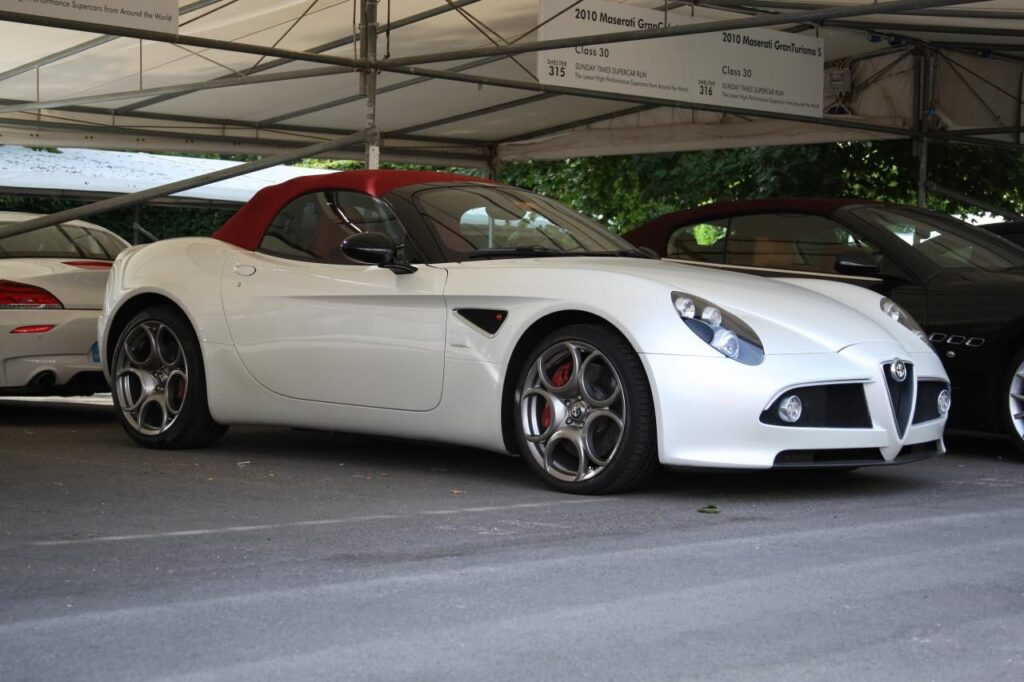
8. **1939 Alfa Romeo 8C 2900B Lungo Spider: Italian Artistry and Engineering Prowess**In the twilight years before the outbreak of World War II, Italian coachbuilders were at the zenith of their craft, creating automotive masterpieces that continue to captivate with their sheer beauty and advanced engineering. The 1939 Alfa Romeo 8C 2900B Lungo Spider, with its exquisite bodywork by Touring, stands as a quintessential example of this golden era, representing the absolute pinnacle of pre-war automotive design.
Experts in the field often describe this car as a rolling sculpture, a perfect marriage of elegant Italian aesthetics and advanced engineering that was genuinely decades ahead of its time. Its sleek lines, purposeful stance, and meticulous detailing showcase an era when craftsmanship and artistry were paramount in car manufacturing, making every curve a stroke of genius.
Beneath its stunning exterior lay a formidable 2.9-liter straight-8 engine, a marvel of engineering for its period, which provided impressive performance capabilities. This Alfa Romeo holds a complicated history regarding its coachwork and engine, yet it remains one of the most striking examples of a classic sports car.
With only 12 extant Touring Spiders, its rarity is unquestionable. Auction records tracked by RM Sotheby’s indicate these automotive gems consistently achieve values around $19-20 million, reflecting not just their scarcity but their profound representation of an era where automotive design was truly an art form. Owning an 8C 2900B Lungo Spider is to possess a direct link to the golden age of Italian motoring and its unparalleled artistry.
Car Model Information: 2020 Audi Q5 45 Premium
Caption: Custom Alfa Romeo 8C (1936)
Name: Alfa Romeo 8C
Manufacturer: Alfa Romeo
Production: 1931–1939
Assembly: Portello (district of Milan)
Class: Luxury car,Sports car,Racing car
Layout: FR layout
Engine: Straight-8
Designer: Vittorio Jano
Categories: 24 Hours of Le Mans race cars, Alfa Romeo sports racing cars, Alfa Romeo vehicles, Articles with short description, Cars introduced in 1931
Summary: The Alfa Romeo 8C was a range of Alfa Romeo road, race and sports cars of the 1930s.
The 8C designates 8 cylinders, and originally a straight 8-cylinder engine. The Vittorio Jano designed 8C was Alfa Romeo’s primary racing engine from its introduction in 1931 to its retirement in 1939. In addition to the two-seater sports cars it was used in the world’s first genuine single-seat Grand Prix racing car, the Monoposto ‘Tipo B’ – P3 from 1932 onwards. In its later development it powered such vehicles as the twin-engined 1935 6.3-litre Bimotore, the 1935 3.8-litre Monoposto 8C 35 Type C, and the Alfa Romeo 8C 2900B Mille Miglia Roadster. It also powered top-of-the-range coach-built production models, including a Touring Spider and Touring Berlinetta.
In 2004 Alfa Romeo revived the 8C name for a V8-engined concept car. This eventually made it into production in 2007, as the 8C Competizione.
Get more information about: Alfa Romeo 8C
Buying a high-performing used car >>>
Brand: Alfa Romeo Model: 8C 2900B Lungo Spider
Price: $20,955 Mileage: 51,510 mi.

9. **1964 Ferrari 250 LM: The Last Le Mans Winner from Maranello**For any racing enthusiast, a victory at the iconic 24 Hours of Le Mans is the ultimate hallmark of a truly great racing car, and few achieve it with the flair and historical significance of the 1964 Ferrari 250 LM. This particular model holds a unique place in history as the last Ferrari to ever win the grueling endurance race, securing its place in motorsport legend and commanding extraordinary prices in the collector’s market.
Only 32 of these incredible Ferraris by Scaglietti were ever made, contributing significantly to their status as some of the most coveted Ferraris in the world. Their design, while purposeful for racing, also embodied the classic Ferrari aesthetic, blending aerodynamic efficiency with undeniable Italian style, making it a visual and performance standout on any track.
Under the bonnet, the 250 LM was powered by a potent 3.3-liter V-12 engine, meticulously tuned to produce 320 horsepower, propelling the car to a top speed of 180 mph. This raw power, combined with a lightweight chassis weighing just 1,940 pounds, made it a formidable competitor on the world’s most challenging circuits.
The significance of the 250 LM was powerfully underscored in early February 2024, when a specific example, lovingly preserved at the Indianapolis Motor Speedway Museum for 54 years and driven by motorsport icon Jochen Rindt, was auctioned by RM Sotheby’s in Paris. It fetched an astonishing €34,880,000, equivalent to approximately $36.2 million, making it a spectacular testament to its enduring legacy and unparalleled desirability among classic car enthusiasts.
Car Model Information: 2020 Audi Q5 45 Premium
Categories: All articles with unsourced statements, Articles with short description, Articles with unsourced statements from June 2019, CS1 French-language sources (fr), CS1 maint: numeric names: authors list
Summary: The Ferrari P was a series of rear mid-engined two seat sports prototype racing car models produced by Ferrari during the 1960s and early 1970s to be raced mainly by the factory Scuderia Ferrari racing team. When a double digit number of identical cars was planned for homologation and sale to customers, the codes LM (Le Mans) or S (Sportscar) were used instead.
Although Enzo Ferrari witnessed the rear mid-engined Auto Union racing cars of the 1930s, and with Cooper dominating F1 with back-to-back World Championship wins, 1959 and 1960, he resisted to move the engine behind the driver even when the Scuderia Ferrari in 1960 put the Dino-V6-engine in the rear of a single seater that resulted in the Ferrari 246 P and the Ferrari 156 F1 “shark nose” that won the 1961 Formula One season.
The Dino V6 with 2,0 or 2,4 litre was also used in the first rear mid-engined Ferrari sport prototypes of the Ferrari SP series of 1961–1962. The 3+ litre V12 sports car racers followed in 1963, starting the P series. Although these cars shared their numerical designations (based on engine displacement) with road models, they were almost entirely different.
The production racers Ferrari 250 LM of 1964 and Ferrari Dino 206S of 1966 were intended for homologation in Gr. 3 or 4 and could be made road legal, to be run with Prova plates, or as ‘Stradale’ for sale to customers in various countries. The first Ferrari mid-engine in a proper road car did not arrive until the 1967 Dino 206 GT, and it was 1971 when a road-going Ferrari 12-cylinder engine was placed behind the driver in the 365 GT4 BB, with V12 front engine GT 2+2 models never been discontinued.
Get more information about: Ferrari P
Buying a high-performing used car >>>
Brand: Ferrari Model: 250 LM
Price: $20,955 Mileage: 51,510 mi.
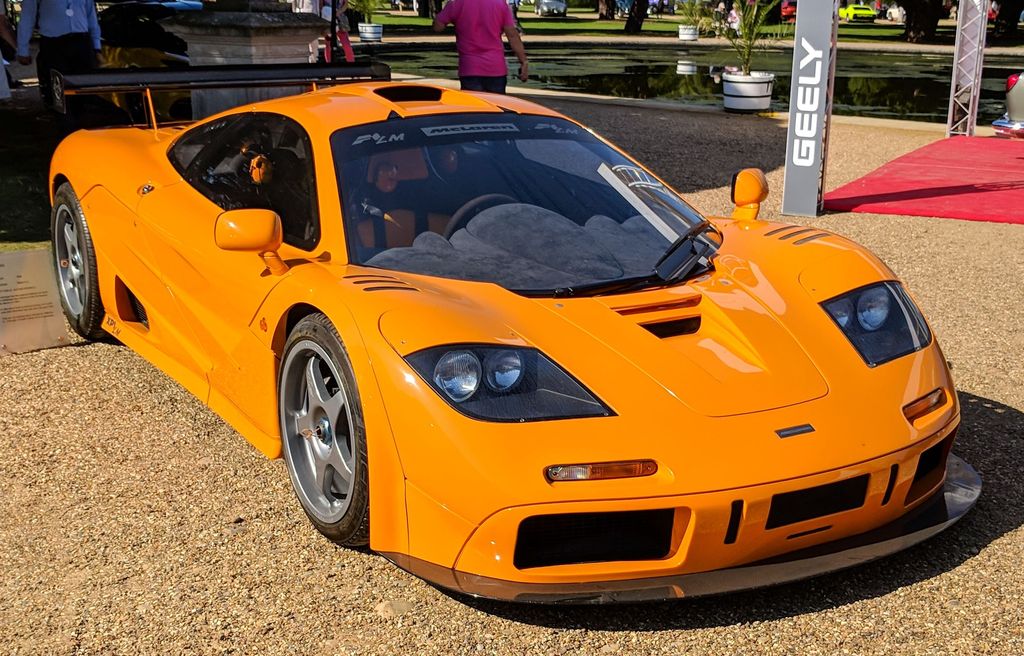
10. **1994 McLaren F1 LM: The Modern Classic That Redefined Supercars**While some purists might argue about what truly constitutes a “classic” given its relatively younger age, the 1994 McLaren F1 has unequivocally earned its place among the automotive legends, proving that revolutionary engineering and extremely limited production can create instant icons. At only 25 years old (at the time of a significant auction), the McLaren F1 had already established itself as an incredible supercar, masterfully designed down to the very last detail by Gordon Murray.
This groundbreaking machine redefined what was possible in automotive performance, distinguished by its unique central driving position and a naturally aspirated 6.0-liter V-12 engine. The F1’s performance figures were staggering: it could hit 100 mph in a blistering 6.3 seconds and devour a quarter-mile straight in just 11.1 seconds, with top speeds exceeding 230 mph.
Only 64 F1s were built between 1994 and 1997, solidifying its extreme exclusivity. The particular F1 “LM” (Le Mans) model was a limited-edition variant created to celebrate the F1’s triumphant victory at the 1995 Le Mans, a testament to its formidable racing pedigree and durability in the most grueling 24-hour race. Its lightweight chassis, weighing 2,425 pounds, further enhanced its dynamic capabilities.
Auction records tracked by Old Cars Magazine show specific F1 models exceeding $20 million. Notably, chassis No. 018 of the F1 LM sold for $19.805 million in August 2019, cementing its status as one of the world’s most valuable cars. For those who witnessed the F1’s debut and grasped its profound significance, observing its meteoric rise to classic status feels like a natural and well-deserved progression for Gordon Murray’s masterpiece.
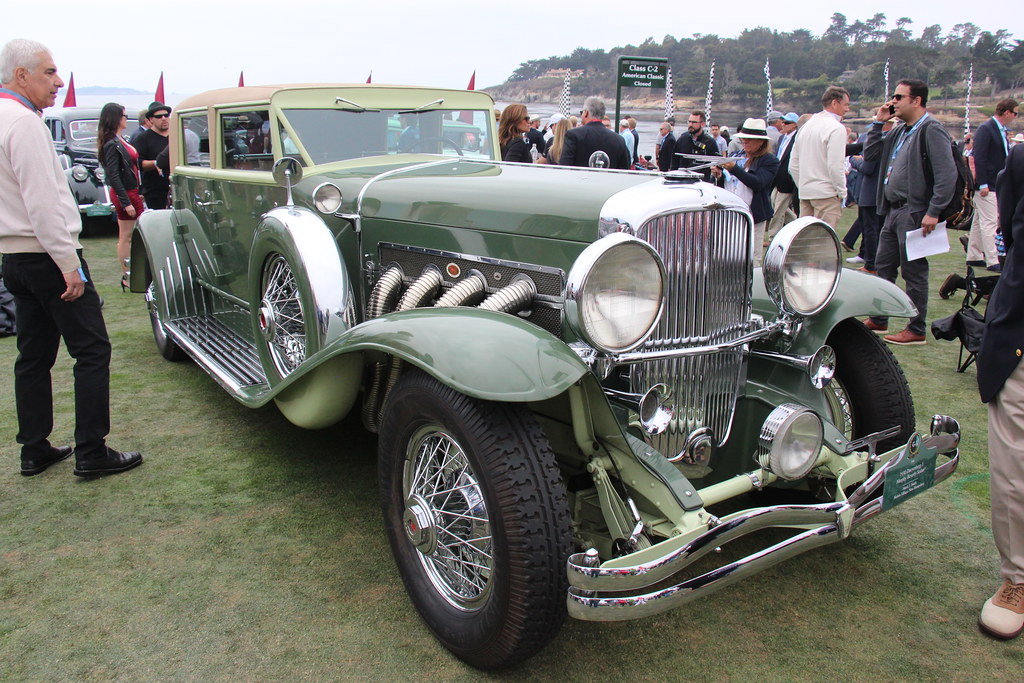
11. **1935 Duesenberg SSJ: American Automotive Aristocracy and Power**For car lovers who appreciate the grandeur and performance of pre-war American automotive engineering, the Duesenberg represented the ultimate expression of luxury and raw power. The 1935 Duesenberg SSJ was the pinnacle of pre-war American automotive achievement, combining unmatched luxury with genuine high performance in a way that truly captivated the discerning few who could acquire it.
This magnificent vehicle boasted an imposing 5,000-pound frame that artfully concealed a massive 7.3-liter supercharged straight-eight engine. This powerhouse was capable of putting out an astonishing 400 horsepower, a figure that was simply staggering for its time, enabling the SSJ to hit 60 mph in less than eight seconds and reach speeds of around 160 mph. Such performance set it apart from virtually all its contemporaries.
Only two SSJ models were ever built, ensuring its extreme rarity and desirability among collectors. One of these legendary cars was famously owned by Hollywood legend Gary Cooper, which undoubtedly added celebrity provenance to its already astronomical value and historical significance. The blend of bespoke luxury and formidable power made it a symbol of American ambition and engineering excellence.
Auction records tracked by Gooding & Company demonstrate these American icons consistently reaching around $22 million, proving that when it came to automotive aristocracy, American manufacturers could indeed play on the same grand stage as the finest European marques. The Duesenberg SSJ stands as a testament to an era when American automakers built cars that were genuinely world-class in every respect, embodying an unparalleled blend of opulence and engineering audacity.
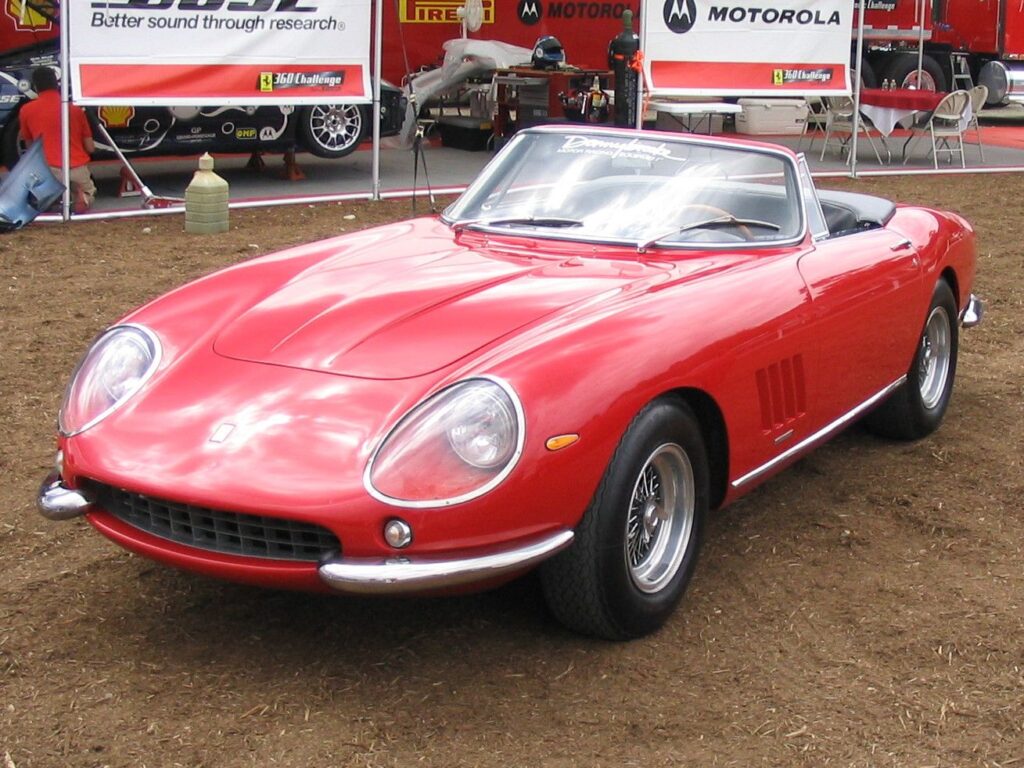
12. **1964 Ferrari 275 GTB/C Speciale: Ultra-Rare Competition Thoroughbred**In the 1960s, as Ferrari continued to cement its reputation as the ultimate manufacturer of high-performance sports cars, it also crafted highly specialized machines for a select group of clients who demanded nothing but the absolute best in competition. The 1964 Ferrari 275 GTB/C Speciale embodies Ferrari at its most exclusive: an ultra-rare, competition-specification version built in numbers so limited that only three examples were ever completed by Ferrari engineer Mauro Forghieri as successors to the revered 250 GTO.
These 275 GTB Competizione Speciale cars were meticulously designed with super-lightweight aluminum bodywork, specifically engineered for the rigors of the 1965 Le Mans race. This dedication to weight reduction and aerodynamic efficiency highlighted Ferrari’s relentless pursuit of victory on the global motorsport stage, showcasing an uncompromising approach to performance.
Under its sleek, purposeful exterior, the Speciale was powered by a 3.3-liter V-12 engine, carefully tuned to produce 230 horsepower, providing it with impressive performance capabilities for its era and a top speed of 160 mph. The combination of its innate racing potential and the iconic, breathtaking 275 GTB design has made it a true unicorn in the world of classic Ferraris.
This extreme rarity, coupled with its profound racing heritage and the sheer beauty of its design, has driven auction values for the 275 GTB/C Speciale to impressive heights, consistently commanding around $26 million. According to data from J.D. Power’s classic car appraisal guide, the Speciale represents the perfect fusion of Ferrari heritage, extreme rarity, and a compelling competition pedigree that is highly sought after by serious collectors worldwide.
Car Model Information: 2020 Audi Q5 45 Premium
Name: Ferrari 275,GTB, GTS, GTB/4, NART Spider
Caption: 1966 Ferrari 275 GTB Series II
Manufacturer: Ferrari
Class: Grand tourer
BodyStyle: unbulleted list
Production: unbulleted list
Wheelbase: 2400 mm
Abbr: on (alloy-bodied 275 GTB/C)
Weight: unbulleted list
Predecessor: Ferrari 250
Successor: unbulleted list
Layout: Front-engine, rear-wheel-drive layout
Engine: unbulleted list
Transmission: transaxle
Designer: unbulleted list
Categories: All articles with dead external links, All articles with unsourced statements, Articles with dead external links from April 2024, Articles with permanently dead external links, Articles with short description
Summary: The Ferrari 275 is a series of front-engined V12-powered grand touring automobiles with two-seater coupé and spider bodies produced by Ferrari between 1964 and 1968. The first 275 series cars were powered by a 3.3 L (3286 cc) overhead camshaft Colombo 60° V12 engine producing 260–320 hp (190–240 kW). An updated 275 GTB/4 was introduced in 1966, with a revised four overhead camshaft engine producing 300 hp (220 kW). The 275 series were the first road-going Ferraris equipped with a transaxle and independent rear suspension.
Pininfarina designed the 275 coupé and spider bodies, while Scaglietti designed the 275 GTS/4 NART Spyder, of which only 10 were made.
Motor Trend Classic named the 275 GTB coupé/GTS spider as number three in their list of the ten “Greatest Ferraris of all time”, and the 275 GTB/4 was named number seven on Sports Car International’s 2004 list of Top Sports Cars of the 1960s. In a September 1967 road test, Road & Track described the NART Spyder as “the most satisfying sports car in the world.”
Get more information about: Ferrari 275
Buying a high-performing used car >>>
Brand: Ferrari Model: 275 GTB/C Speciale
Price: $20,955 Mileage: 51,510 mi.

13. **1967 Ferrari 275 GTB/4*S NART Spider: Open-Air Italian Perfection for America**In the late 1960s, a unique demand emerged from American Ferrari enthusiasts for the ultimate open-air driving experience, leading Luigi Chinetti’s North American Racing Team (NART) to commission something truly extraordinary. The 1967 Ferrari 275 GTB/4*S NART Spider was born from this desire, combining Ferrari’s most beautiful and revered design with the pure, exhilarating joy of top-down motoring.
This stunning convertible, based on the 275 GTB/4, quickly became one of the rarest Ferraris ever created, with only ten examples ever built specifically for the American market, despite original plans for a larger production run. Its Pininfarina-designed bodywork exuded an undeniable elegance and sportiness, perfectly encapsulating the spirit of the era.
Under the sculpted hood lay a formidable 3.3-liter V-12 engine, capable of producing 300 horsepower, propelling this open-top beauty to a top speed of 166.5 mph. Weighing 2,866 lbs, it offered an engaging and powerful driving experience, making it a favorite among discerning drivers who craved both performance and style.
The NART Spider gained significant pop culture recognition, notably in the movie “The Thomas Crown Affair,” further cementing its iconic status and desirability. Classic Driver market analysis consistently shows these open-top beauties regularly commanding around $27 million at auction, with a specific example selling for $27.5 million in 2013, with the proceeds generously donated to charity. Its blend of rarity, performance, and exquisite styling makes it a true masterpiece of open-air Italian perfection.
Car Model Information: 2020 Audi Q5 45 Premium
Name: Ferrari 275,GTB, GTS, GTB/4, NART Spider
Caption: 1966 Ferrari 275 GTB Series II
Manufacturer: Ferrari
Class: Grand tourer
BodyStyle: unbulleted list
Production: unbulleted list
Wheelbase: 2400 mm
Abbr: on (alloy-bodied 275 GTB/C)
Weight: unbulleted list
Predecessor: Ferrari 250
Successor: unbulleted list
Layout: Front-engine, rear-wheel-drive layout
Engine: unbulleted list
Transmission: transaxle
Designer: unbulleted list
Categories: All articles with dead external links, All articles with unsourced statements, Articles with dead external links from April 2024, Articles with permanently dead external links, Articles with short description
Summary: The Ferrari 275 is a series of front-engined V12-powered grand touring automobiles with two-seater coupé and spider bodies produced by Ferrari between 1964 and 1968. The first 275 series cars were powered by a 3.3 L (3286 cc) overhead camshaft Colombo 60° V12 engine producing 260–320 hp (190–240 kW). An updated 275 GTB/4 was introduced in 1966, with a revised four overhead camshaft engine producing 300 hp (220 kW). The 275 series were the first road-going Ferraris equipped with a transaxle and independent rear suspension.
Pininfarina designed the 275 coupé and spider bodies, while Scaglietti designed the 275 GTS/4 NART Spyder, of which only 10 were made.
Motor Trend Classic named the 275 GTB coupé/GTS spider as number three in their list of the ten “Greatest Ferraris of all time”, and the 275 GTB/4 was named number seven on Sports Car International’s 2004 list of Top Sports Cars of the 1960s. In a September 1967 road test, Road & Track described the NART Spyder as “the most satisfying sports car in the world.”
Get more information about: Ferrari 275
Buying a high-performing used car >>>
Brand: Ferrari Model: 275 GTB/4*S NART Spider
Price: $20,955 Mileage: 51,510 mi.
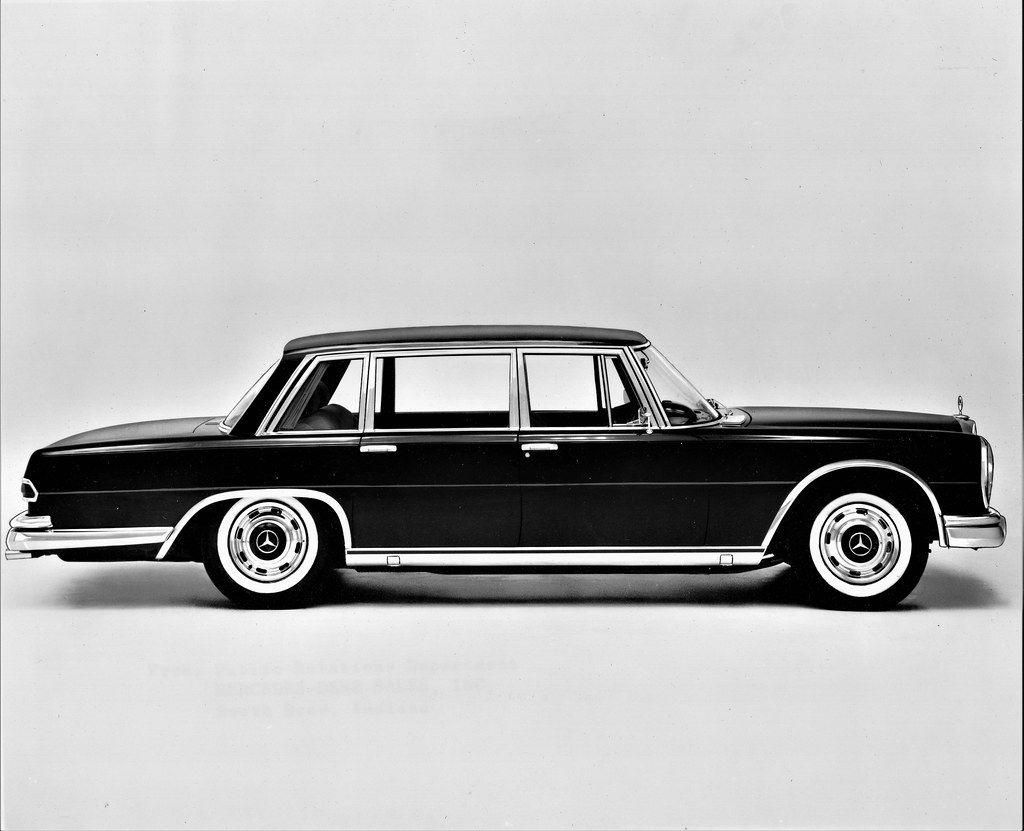
14. **1954 Mercedes-Benz W 196 R Stromlinienwagen: The Aerodynamic Racing Innovator**While the open-wheel “Silver Arrow” W196R Formula 1 car captivated audiences with its raw power and precision, Mercedes-Benz also pushed the boundaries of aerodynamic design with another variant of the W196R platform: the 1954 Mercedes-Benz W 196 R Stromlinienwagen. This enclosed, streamlined racing car was a visionary machine, specifically developed for high-speed circuits where aerodynamic efficiency was paramount, showcasing German engineering’s relentless pursuit of innovation.
The Stromlinienwagen, which translates to “streamlined car,” featured a distinctive, fully enveloping body designed to minimize drag and maximize top speed on fast tracks. This radical design, a stark contrast to its open-wheel counterpart, was a testament to Mercedes-Benz’s forward-thinking approach to motorsport, aiming to gain every possible advantage in the fierce competition of 1950s Formula 1 racing.
Equipped with the innovative 2.5-liter, 8-cylinder in-line engine, identical to that of its open-wheel sibling, the Stromlinienwagen delivered immense power and reliability. This powerful bloc was at the heart of Mercedes-Benz’s dominance in the 1954 and 1955 seasons, allowing its drivers, including the legendary Juan Manuel Fangio, to achieve remarkable speeds and secure crucial victories.
During the prestigious Goodwood ‘Festival of Speed’ in 2013, Bonhams offered an impressive Mercedes-Benz W196 Stromlinienwagen from 1954, which sold for an astounding $29,650,095. This sale underscores the profound historical significance and immense value placed on this pioneering aerodynamic racer. The Stromlinienwagen represents a critical chapter in motorsport history, demonstrating how Mercedes-Benz integrated cutting-edge scientific principles with powerful engineering to create a truly dominant and visually striking racing machine.
Car Model Information: 2020 Audi Q5 45 Premium
Caption: Nürburgring
CarName: Mercedes-Benz W196
Category: Formula One
Constructor: Mercedes-Benz in Formula One
Successor: Mercedes MGP W01
Team: Mercedes-Benz in Formula One
Drivers: flagicon,Stirling Moss,flagicon,Karl Kling
EngineName: Mercedes-Benz,Mercedes-Benz M196 engine
Configuration: Inline 8 engine
Capacity: cvt
Tyres: Continental AG
Debut: 1954 French Grand Prix
FirstWin: 1954 French Grand Prix
Races: 12
ConsChamp: 0
DriversChamp: 1954 Formula One season,1955 Formula One season
LastWin: 1955 Italian Grand Prix
LastEvent: 1955 Italian Grand Prix
Wins: 9
Poles: 8
FastestLaps: 9
Podiums: 17
Designer: Rudolf Uhlenhaut
Categories: 1954 Formula One season cars, 1955 Formula One season cars, All articles needing additional references, Articles needing additional references from February 2018, Articles with hAudio microformats
Summary: The Mercedes-Benz W196 (sometimes written as the Mercedes-Benz W 196 R) was a Formula One racing car produced by Mercedes-Benz for the 1954 and 1955 F1 seasons. Successor to the W194, in the hands of Juan Manuel Fangio and Stirling Moss it won 9 of 12 races entered and captured the only two world championships in which it competed.
Firsts included the use of desmodromic valves and Daimler-Benz developed mechanical direct fuel injection adapted from the DB 601 high-performance V12 used on the Messerschmitt Bf 109E fighter during World War II.
The 3-litre 300 SLR was derived from the W196 for the 1955 World Sportscar Championship season. Its crash at Le Mans that year ended not only its own short-lived domination but also spelled the end for the W196. Mercedes pulled out of competitive racing in 1955 and did not return for another three decades.
Get more information about: Mercedes-Benz W196
Buying a high-performing used car >>>
Brand: Mercedes-Benz Model: W 196 R
Price: $20,955 Mileage: 51,510 mi.
Looking back at these twelve automotive masterpieces, it’s truly remarkable to consider that many of these cars were once simply the dream machines of our youth, the exotic beauties we admired in magazines, movies, and car shows. Today, they’ve transcended their original purpose to become some of the most valuable collectibles on Earth, with prices that would have seemed utterly impossible just a few decades ago. These beauties are not just rolling pieces of history; they are technological miracles and artistic achievements that represent the pinnacle of automotive craftsmanship from their different eras. Whether it’s the Formula 1 pedigree of a Mercedes Silver Arrow, the racing glory of a Ferrari 250 GTO, or the artistic brilliance of a Bugatti Atlantic, each of these vehicles tells a compelling story of human ingenuity, passion, and the eternal quest for automotive perfection. For those of us who grew up dreaming about these cars, their astronomical values today serve as compelling proof that sometimes, our youthful fascinations were indeed worth more than we ever could have imagined. These automotive icons are not just investments; they are legacies, waiting to inspire future generations of enthusiasts and collectors.


